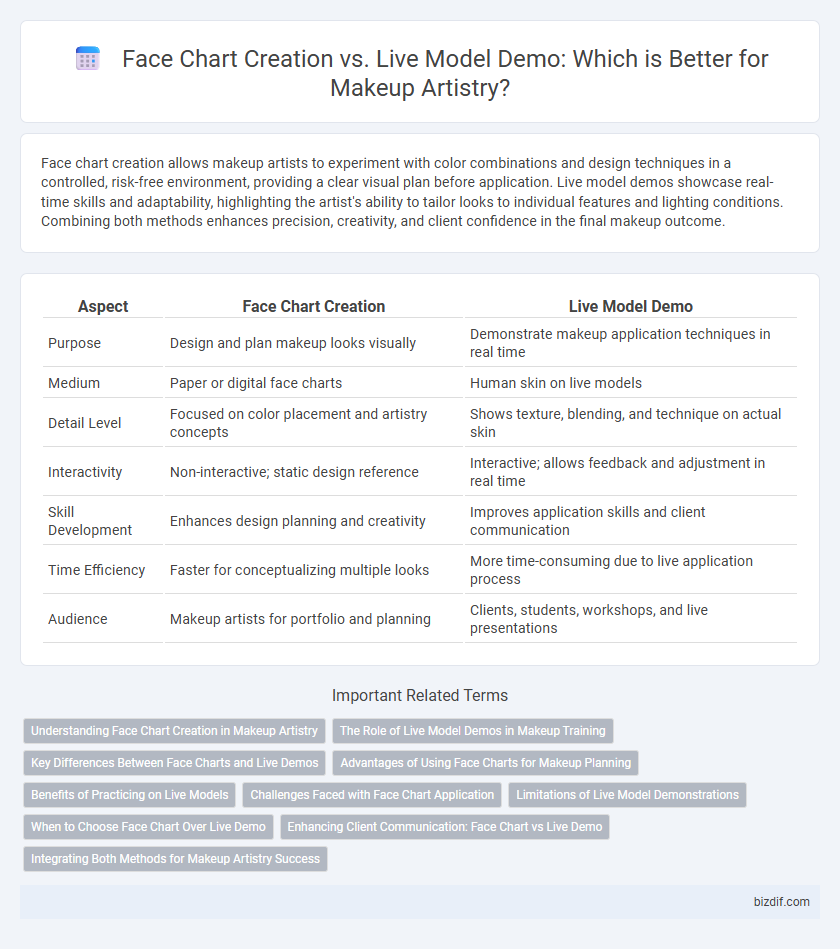Face chart creation allows makeup artists to experiment with color combinations and design techniques in a controlled, risk-free environment, providing a clear visual plan before application. Live model demos showcase real-time skills and adaptability, highlighting the artist's ability to tailor looks to individual features and lighting conditions. Combining both methods enhances precision, creativity, and client confidence in the final makeup outcome.
Table of Comparison
| Aspect | Face Chart Creation | Live Model Demo |
|---|---|---|
| Purpose | Design and plan makeup looks visually | Demonstrate makeup application techniques in real time |
| Medium | Paper or digital face charts | Human skin on live models |
| Detail Level | Focused on color placement and artistry concepts | Shows texture, blending, and technique on actual skin |
| Interactivity | Non-interactive; static design reference | Interactive; allows feedback and adjustment in real time |
| Skill Development | Enhances design planning and creativity | Improves application skills and client communication |
| Time Efficiency | Faster for conceptualizing multiple looks | More time-consuming due to live application process |
| Audience | Makeup artists for portfolio and planning | Clients, students, workshops, and live presentations |
Understanding Face Chart Creation in Makeup Artistry
Face chart creation in makeup artistry serves as a vital planning tool that allows artists to experiment with color schemes, techniques, and designs on paper before applying them to a live model. It enhances precision and creativity by providing a clear visual roadmap, helping to avoid errors during live demonstrations. Mastery of face chart creation supports efficient workflow and client communication, ensuring desired outcomes in makeup artistry projects.
The Role of Live Model Demos in Makeup Training
Live model demos are essential in makeup training, providing hands-on experience that enhances learners' understanding of contouring, blending, and product application in real time. Unlike face chart creation, which emphasizes design planning on paper, live demos develop skills in adapting techniques to diverse skin textures and facial structures. This practical approach ensures makeup artists gain confidence and proficiency necessary for professional client interactions.
Key Differences Between Face Charts and Live Demos
Face chart creation allows makeup artists to experiment with colors, shapes, and techniques on paper, providing a visual blueprint that can be referred to later, while live model demos showcase the application process in real-time, highlighting skills like blending and precision on actual skin. Face charts emphasize permanence and planning, ideal for portfolio building and client consultations, whereas live demos emphasize interaction, adaptability, and the ability to work with different skin textures and features. The key difference lies in face charts being static, controlled representations, whereas live demos provide dynamic, hands-on experiences that capture the artistry in practice.
Advantages of Using Face Charts for Makeup Planning
Face chart creation allows makeup artists to experiment with color combinations, techniques, and product placements without the constraints of working on a live model, enabling precise planning and adjustment. This method provides a visual blueprint that can be easily shared with clients or team members, streamlining communication and ensuring consistent results. Face charts also save time and resources by eliminating the need for multiple live trials, making them an efficient tool for pre-visualizing makeup designs.
Benefits of Practicing on Live Models
Practicing makeup artistry on live models enhances real-time adaptability and perfects application techniques under dynamic conditions, offering immediate feedback on product performance and skin reaction. Unlike face chart creation, live model demos develop communication skills and build confidence essential for client interactions. This hands-on experience also improves color matching accuracy and technique precision, crucial for professional makeup artists.
Challenges Faced with Face Chart Application
Face chart creation poses challenges in accurately translating colors and textures due to the lack of real skin tone variation and three-dimensional contours. The two-dimensional surface limits the assessment of blending techniques and product performance under different lighting conditions. Face charts also fail to capture dynamic facial expressions, making it difficult to visualize the final makeup look on a live model.
Limitations of Live Model Demonstrations
Live model demonstrations face limitations such as time constraints, which restrict the complexity and diversity of makeup techniques showcased. Variability in the model's skin type, facial features, and lighting conditions can affect the consistency and reproducibility of the makeup application process. Unlike face charts, live demos do not allow for detailed annotations or corrections, making it harder to convey step-by-step instructions clearly.
When to Choose Face Chart Over Live Demo
Face charts are ideal for planning intricate makeup designs and documenting specific color combinations, making them perfect for creative experimentation and client consultations. Choose face charts when time constraints or hygiene concerns limit the feasibility of a live model demo. They provide a clear visual reference that can be easily adjusted before applying makeup on a live model.
Enhancing Client Communication: Face Chart vs Live Demo
Face chart creation offers a precise visual reference that enhances client communication by allowing detailed planning of makeup looks before application, reducing misunderstandings. Live model demos provide real-time interaction, enabling clients to see techniques and adjustments firsthand, fostering immediate feedback and trust. Combining both methods optimizes client satisfaction by balancing structured visualization with dynamic demonstration.
Integrating Both Methods for Makeup Artistry Success
Integrating face chart creation with live model demos enhances makeup artistry by combining precise planning with real-time application adjustments, ensuring customized and flawless results. Face charts provide a detailed visual blueprint that guides product selection and color schemes, while live demos allow for dynamic interaction with skin textures and lighting conditions. This dual approach optimizes creativity, accuracy, and client satisfaction in professional makeup artistry.
Face Chart Creation vs Live Model Demo Infographic

 bizdif.com
bizdif.com